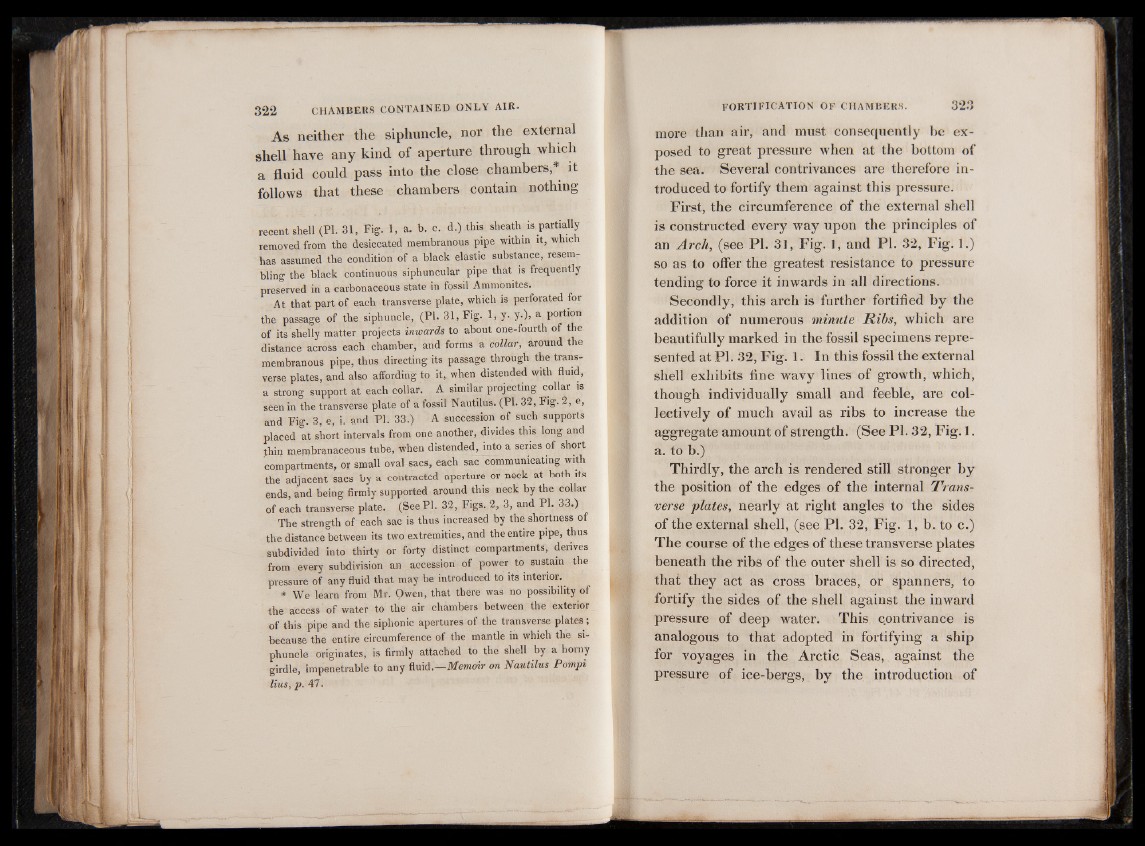
As neither the siphuncle, nor the external
shell have any kind of aperture through which
a fluid could pass into the close chambers,* it
follows that these chambers contain nothing
recent shell (Pl. 31, Fig. 1, a. b. c. d.) this sheath is partially
removed from the desiccated membranous pipe within it, which
has assumed the condition of a black elastic substance, resembling
the black continuous siphuncular pipe that is frequently
preserved in a carbonaceous state in fossil Ammonites.
At that part of each transverse plate, which is perforated for
the passage of the siphuncle, (PI. 31, Fig. 1, y. y.)> a portion
of its shelly matter projects inwards to about one-fourth of the
distance across each chamber, and forms a collar, around the
membranous pipe, thus directing its passage through the transverse
plates, and also affording to it, when distended with fluid,
a strong support at each collar. A similar projecting collar is
seen in the transverse plate of a fossil Nautilus. (PI. 32, Fig. 2, e,
and Fig. 3, e, i. and PI. 33.) A succession of such supports
placed at short intervals from one another, divides this long and
thin membranaceous tube, when distended, into a series of short
compartments, or small oval sacs, each sac communicating with
the adjacent saes by a contracted aperture or neck at both its
ends, and being firmly supported around this neck by the collar
of each transyerse plate. (See PL 32, Figs. 2, 3, and PI. 33.)
The strength of each sac is thus increased by the shortness of
the distance between its two extremities, and the entire pipe, thus
subdivided into thirty or forty distinct compartments, derives
from every subdivision an accession of power to sustain the
pressure of any fluid that may be introduced to its interior.
* We learn from Mr. Owen, that there was no possibility of
the access of water to the air chambers between the exterior
of this pipe and the siphonic apertures of the transverse plates;
because the entire circumference of the mantle in which the siphuncle
originates, is firmly attached to the shell by a horny
girdle, impenetrable to any fluid.—Memoir on Nautilus Pompi
lius, p. 47.
more than air, and must consequently be exposed
to great pressure when at the bottom of
the sea. Several contrivances are therefore introduced
to fortify them against this pressure.
First, the circumference of the external shell
is constructed every way upon the principles of
an Arch, (see PI. 31, Fig. 1 , and PI. 32, Fig. 11)
so as to offer the greatest resistance to pressure
tending to force it inwards in all directions.
Secondly, this arch is further fortified by the
addition of numerous minute Ribs, which are
beautifully marked in the fossil specimens represented
at PI. 32, Fig. 1 . In this fossil the external
shell exhibits fine wavy lines of growth, which,
though individually small and feeble, are collectively
of much avail as ribs to increase the
aggregate amount of strength. (See PI. 32, Fig. 1 .
a. to b.)
Thirdly, the arch is rendered still stronger by
the position of the edges of the internal Transverse
plates, nearly at right angles to the sides
of the external shell, (see Pl. 32, Fig. 1 , b. to c.)
The course of the edges of these transverse plates
beneath the ribs of the outer shell is so directed,
that they act as cross braces, or spanners, to
fortify the sides of the shell against the inward
pressure of deep water. This qontrivance is
analogous to that adopted in fortifying a ship
for voyages in the Arctic Seas, against the
pressure of ice-bergs, by the introduction of